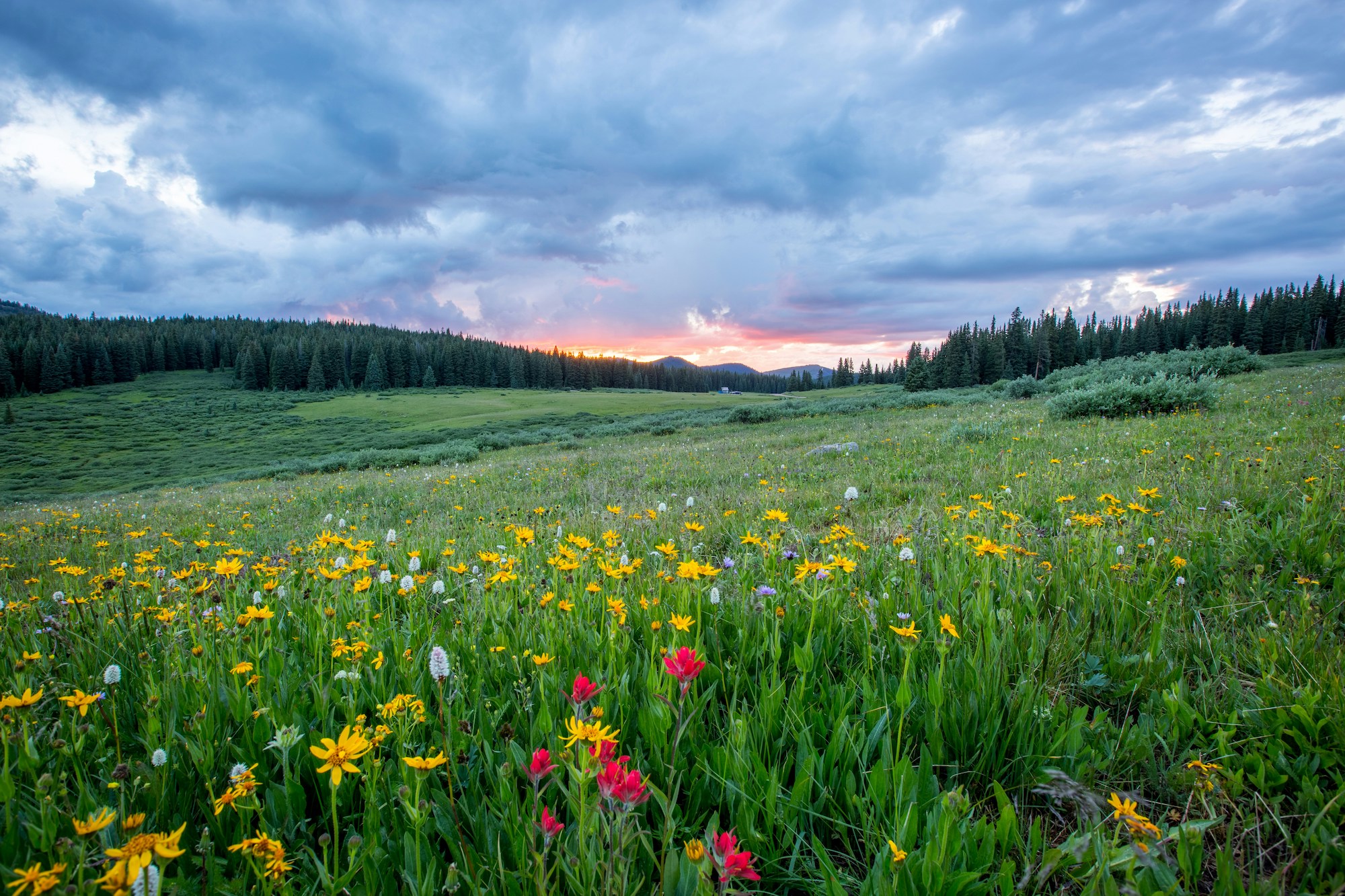Spring is a marvelous time to hike the 800-plus miles of trails in Great Smoky Mountains National Park. One major reason for spring hikes? The spectacular profusion of wildflowers that carpet the forest floor in these lush, bio-diverse old highlands of the Southern Appalachians.
The Best Spring Hikes in the Smoky Mountains

The following roundup pulls together 10 awesome hiking trails in the park—running the gamut from short and easy to long and demanding—which offer primo blooms as well as other springtime pleasures.
Abrams Falls Trail
Difficulty: Moderate
Round-trip Distance: 5.2 miles
Duration: ~3 hours
Kicking off from the magical, wildlife-packed basin of Cades Cove, the Abrams Falls Trail leads to one of the many waterfalls that gush and roar along the drainages of the Great Smokies. In fact, Abrams Falls—though a mere 20 or so feet tall—is the most voluminous of all the Smoky Mountain waterfalls.
Along the way to that whitewater pour-off, keep your eyes peeled for a plethora of trailside spring wildflowers, from bluets, bleeding heart, and star grass to wandflower, hawkweek, trailing arbutus, and wintergreen, among others.
Alum Cave Trail
Difficulty: Strenuous
Round-trip Distance: 11 miles
Duration: ~8 hours (if going all the way to the summit of Mount LeConte)
One of a number of spectacular hiking trails that climb to the top of 6,593-foot Mount LeConte—the great massif that ranks as the third-highest peak in the Great Smokies and one of the most topographically imposing mountains in the East—the Alum Cave Trail will make you huff and puff, but it’s all worth it.
Along with such impressive geologic formations as Arch Rock and Alum Cave (actually an enormous alcove, not a cave), the trail shows off fine springtime blossoms, from various trilliums to Dutchman’s breeches.
Charlies Bunion
Difficulty: Strenuous
Round-trip Distance: 8.1 miles
Duration: 4 hours, 30 minutes
Mostly playing out on the legendary Appalachian Trail, the hike to the goofily named but grand-looking rock formation known as Charlies Bunion is one of the classic adventures along the main Smoky Mountain divide. The big crag in question serves up a stunning view, and introduces hikers to the rock formation responsible for some of the all-around roughest terrain in the Great Smokies: the Anakeesta slate.
Look for trout-lilies, violets, spring beauties, and other groundcover blooms as you trek to the “Bunion” and its knockout vista.
Chimney Tops Trail
Difficulty: Strenuous
Round-trip Distance: 3.8 miles
Duration: 3 hours, 30 minutes
The Chimney Tops are another raw and spectacular exposure of the Anakeesta Formation, forming one of the truly iconic landmarks of the Great Smoky Mountains National Park.
A demanding hike takes you to a wonderful viewpoint of their toothy profile, as well as the nearby swell of Mount LeConte. Spring wildflowers you might spot along the way include trilliums and fringed phacelia.
Rich Mountain Loop
Difficulty: Strenuous
Round-trip Distance: 8.5 miles
Duration: 4 hours, 45 minutes
A good trail for sniffing out solitude close to one of the busiest corners of the Great Smoky Mountains National Park, the Rich Mountain Loop explores the high-country hinterland edging Cades Cove to the north.
The impressive elevational range on this loop hike presents quite a range of springtime wildflowers, including butterfly weed, purple phacelia, and rattlesnake hawkweed.
Porters Creek Trail
Difficulty: Moderate
Round-trip Distance: 6 miles
Duration: 3 hours, 40 minutes
Explore the quiet (and historically rich) backwoods of the Greenbrier area on the Porters Creek Trail, which besides remnants of old homesteads and the lovely cascade of Fern Branch Falls features such spring blooms as wild geranium, dwarf ginseng, speckled wood lily, showy orchid, and violets.
Little River Trail
Difficulty: Easy
Round-trip Distance: 4.9 miles
Duration: 2 hours, 45 minutes
The pleasant sylvan path of the Little River Trail, which starts near the Elkmont Campground, is one of the celebrated spring wildflower ambles in the Great Smokies. Take it slow and admire such seasonal beauties as dwarf cinquefoil, foamflower, trilliums, Solomon’s-seal, phlox, and Canadian violet.
Chestnut Top Trail
Difficulty: Moderate-strenuous
Round-trip Distance: 8.6 miles
Duration: 5 hours, 30 minutes
Its trailhead only a few miles from Townsend, Tennessee, the Chestnut Top Trail is another of the widely celebrated wildflower hikes in the Great Smoky Mountains.
The trail climbs to a ridge top ramble up on Chestnut Top Lead, but many folks content themselves with the first, lower section of trail, which throughout spring comes awash in floral finery: hepatica, rue anemone, crested dwarf iris, purple phacelia, star grass, chickweed, bloodroot, rattlesnake hawkweed, and more.
Schoolhouse Gap Trail
Difficulty: Easy
Round-trip Distance: 3.8 miles
Duration: 3 hours
Linkable with the Chestnut Top Trail, the Schoolhouse Gap Trail is another rewarding spring hike that abounds with wildflowers, from bluebells and Robin’s plantain to cardinal flowers and pink lady’s slipper.
A popular though unofficial side path off the Schoolhouse Gap Trail leads to the enigmatic little basin called White Oak Sink (or White Oak Sinks), a standout spot for botanical appreciation; look for phlox, bloodroot, dog hobble, mayapple, trillium, and more here. (Be aware that the Park Service may limit group size for visits to White Oak Sink, given the ecological uniqueness of the site and its sensitivity to trampling. Check with a park ranger before heading that way.)
Middle Prong Trail
Difficulty: Moderate-strenuous
Round-trip Distance: 8.3 miles
Duration: 4 hours, 15 minutes
Named for the Middle Prong Little River, this trail partly follows an old railroad grade dating to the Little River Lumber Company days. Known for multiple cascades and waterfalls (such as Indian Flats Falls), the Middle Prong Trail is also yet another winner when it comes to vernal blooms: Look for wild ginger, jack-in-the-pulpit, dwarf iris, and more.
Enjoy Wildflowers & Other Seasonal Natural Attractions on a Springtime Getaway to Great Smoky Mountains National Park

Viewing, identifying, and photographing the wildflowers that fire up the groundcover of the Great Smoky Mountains in the springtime makes for timeless seasonal pleasures in this most popular—and most biologically diverse—national park in the U.S. And given the blooms keep coming through summer and into the fall, the springtime spectacle is only the (magnificent) launch of the year’s floral pageantry!




